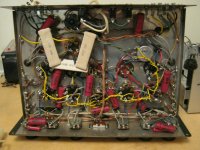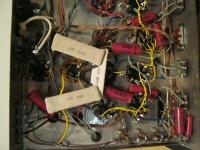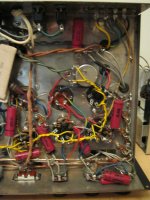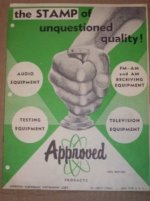I thought that might be a kit because the parts are bolted on rather then riveted, which is the norm for a manufacturer. Now I'm sure it was.
Vtg Approved Electronic Instrument Catalog~Testers~Amps | eBay
Vtg Approved Electronic Instrument Catalog~Testers~Amps | eBay
Attachments
Last edited:
It's OLD. Notice the use of binaural wording and independence of the 2 channels. I'm guessing the rectifier is a 5Y3 and that it uses single ended (SE) 6V6 O/P tubes. Please provide a complete list of the tube complement.
FWIW, I'd salvage the "iron" and tubes for recycling into a new build. All of the electrolytic caps. are "shot". Carbon composition resistors drift in value and go noisy over time, which makes them poor salvage candidates. Wirewound resistors in good physical condition are candidates for salvage.
BTW, if in good condition, the "magic eye" indicator tubes are of value to radio restorers.
I think that would be an absolute waste
"Different strokes for different folks." I think the tuning eyes are "hokey" and those tubes are badly needed by antique radio restorers. When I suggested salvage, I DIDN'T exclude salvage in place. Undoubtedly, the tone controls are poor, as really good TCs are anything but simple. Reduce the amp to simple triode strapped SE 6V6s and no GNFB, with a volume control setup at the voltage amplifier I/Ps. Yes, that's only 2 WPC, but those are some FINE sounding W., indeed. Fabricate a new faceplate from sheet aluminum. Keep it clean and uncluttered. IMO, 3 knobs are plenty. Two knobs are for volume control (either twin mono or ganged vol. & bal.) and the 3rd is for a ganged source selector switch. A highly suitable selector switch is the $4.76 Lorlin CK1459 from Mouser (stock # 105-14572).
BTW, I still want to know what the OEM tube complement is.
BTW, I still want to know what the OEM tube complement is.
IMHO, it's rare and more of a museum piece. I'd do a minimal restoration, keeping everything visually original, or you'll destroy its value. Don't replace anything that isn't measurably bad because its "old". Screw the radio restorers- eye tubes aren't that hard to source and I think there are even new reproductions available.
I am totaly new to all this, .... I am learning and have all new equipment to start off with. Reading and reading all I can
WO
I think you have a great amp to learn from. You wouldn't need to change anything above the chassis or on the faceplate - so the character could remain the same and if you stay initially with the same circuit then the amp retains its 'value', and you can revisit it in years to come with more experienced eyes. There is enough room underneath to place new electrolytics and any other tweaks.
If you keep reading, and show that you are keen to learn then I'm sure that others would assist you in understanding and modifying the amp a bit at a time. Restorations are typically not quick fixes, and 80% of effort can be required before you ever get to think about turning the power on - and even then you can initially get an experienced service person to either do the mains connection or cross-check what you have done.
I can recommend websites like Classic ANZ Valve Guitar Amplifiers to check through pages relating to caps, mains, safety, transformer testing, etc. Check out some basic electronics education pages etc. Try to trace out the circuit schematic and then ask for help for someone to cross-check against the photos - then identify the stages of the amp and check out what other amps use those stages.
Just my 2 cents worth
OK here is what we got,
4x RCA 629 on glass
4x GE 112156 the 4 black ones with the wire going to the top
2x Sonora 6v6
1x GE electrostatic 67c7
1x RCA 5y3 GT
WO
2X 6V6 and a 5Y3 make sense. I think the metal envelope tube is a 6SC7. The 4 "thingies" with wires to their tops may be wirewound resistors.
Did you come up with any documentation, especially an OEM schematic?
I can say for sure nothing but a re-store for this baby.
Here is the underneath.
WO
Looks like Tiny Chief capacitors, they are usually still great.
Just replace electrolytics and enjoy. Most probably this stereo SE amp uses 6V6 output tubes and 6SJ7 in preamp.
I mean, solder new electrolytics under existing big cans to keep look'n feel intact.
Last edited:
to keep look'n feel intact.
I have some trouble understanding why people like to keep things looking original inside the chassis. I have seen people trying to make new caps look old with elaborate stickers. I like the aesthetic side of it and also like carbon comp resistors for the same reason but why go all that trouble? Has anyone ever heard of plastic surgery for the guts? Who cares how they look? Are you going to be watching it?
IMO this isn't an art piece, this is for listening to music. Bypass the tone controls and make that pentode a triode. It will sound much better. Keep the front plate as it is because it looks good, the wiring layout looks like crap, no reason to keep it like that.
- Status
- This old topic is closed. If you want to reopen this topic, contact a moderator using the "Report Post" button.
- Home
- Amplifiers
- Tubes / Valves
- Look what I found!



